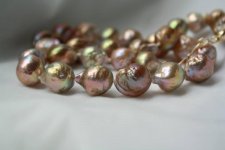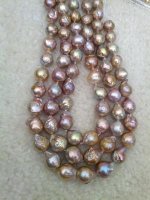(Laugh) Those icky bits take some time to fall in love with most definitely. But again from what I understand the amazing colours in the Kojima Japanese strand that no freshwater pearl can come close to (correction: Grace's Edisons apparently have but they are 5-6 figures per strand [pearl people, pls correct if my memory fails me] and those are Chinese freshwaters!!) are beacause they are in-body nucleated and therefore have blemishes (pitting, divots etc). You got to read more about the phenomenon here; that's where I started my 'education' then subsequently found PG:
http://pacificpearls.us/in-body-bead-nucleated-freshwater-pearls/2/
I think if I can summarise my pearl journey:
Stage 1: Bought Chinese freshwater round pearls with good lustre and thought, wow, I did good for this price (not that I could then afford a Mikimoto).
Stage 2: Bought more Chinese freshwaters and spied some interesting keshi with amazing lustre and iridescent skins and thought, could they get any better?
Stage 3: Bought smooth-skinned flameball and fireball nucleated pearls and thought by golly, I have south sea baroque pearls on a bargain (As if! Now that I own baroque and freeform SSPs, I know only the shape is similar, not the lustre nor the nacre. It's a whole different ballgame and it explains too the price jump)
Stage 4: Bought Chinese wrinkly and textured (predominantly the mauves, purple-greens, pinks) and smooth (creams, golds, whites) lookalike kasumis and my hypothesis is - the more lively and saturated and iridescent the colour, the tradeoff is in the smoothness of the skin hence the icky bits and bumps. And as for my most expensive cfw kashumi lookalike pearls, despite their iridesence, it can't seem to compare with the Japanese kasumis and that's just by comparing with the photos.
I'm now in Stage 5 from my pearl journey - the holy grail of saltwater akoyas, SSPs, tahitians, Sea of Cortez pearls (I only own one) and of course, my baby abalone naturals. I think I still have some way more to go

I think all my preaching won't convince you, it's the fondling that'll get you converted. BIG GRIN.
 (It's okay, y'all can tell me, really)...
(It's okay, y'all can tell me, really)...












